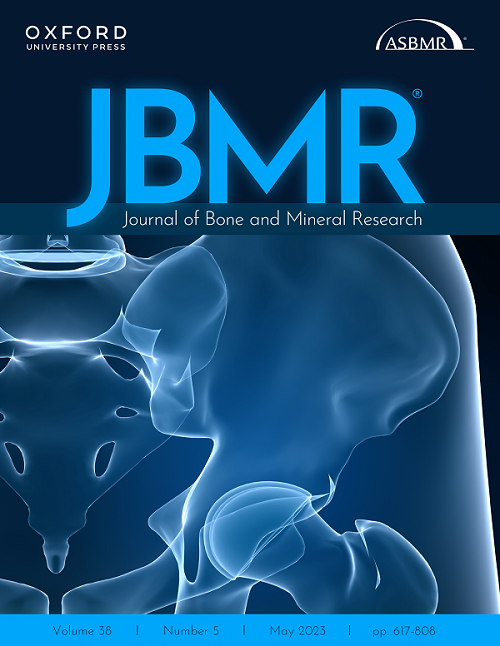下载PDF
{"title":"罕见和常见的GALNT3变异可能独立于磷酸盐代谢影响骨量","authors":"Neelam Hassan, Celia L. Gregson, Haotian Tang, Marc van der Kamp, Paul Leo, Aideen M. McInerney-Leo, Jie Zheng, Maria Luisa Brandi, Jonathan C. Y. Tang, William Fraser, Michael D. Stone, Elin Grundberg, Anglo-Australasian Genetics Consortium, Matthew A. Brown, Emma L. Duncan, Jonathan H. Tobias","doi":"10.1002/jbmr.4795","DOIUrl":null,"url":null,"abstract":"<p>Anabolic treatment options for osteoporosis remain limited. One approach to discovering novel anabolic drug targets is to identify genetic causes of extreme high bone mass (HBM). We investigated a pedigree with unexplained HBM within the UK HBM study, a national cohort of probands with HBM and their relatives. Whole exome sequencing (WES) in a family with HBM identified a rare heterozygous missense variant (NM_004482.4:c.1657C > T, p.Arg553Trp) in <i>GALNT3</i>, segregating appropriately. Interrogation of data from the UK HBM study and the Anglo-Australasian Osteoporosis Genetics Consortium (AOGC) revealed an unrelated individual with HBM with another rare heterozygous variant (NM_004482.4:c.831 T > A, p.Asp277Glu) within the same gene. In silico protein modeling predicted that p.Arg553Trp would disrupt salt-bridge interactions, causing instability of GALNT3, and that p.Asp277Glu would disrupt manganese binding and consequently GALNT3 catalytic function. Bi-allelic loss-of-function <i>GALNT3</i> mutations alter FGF23 metabolism, resulting in hyperphosphatemia and causing familial tumoral calcinosis (FTC). However, bone mineral density (BMD) in FTC cases, when reported, has been either normal or low. Common variants in the <i>GALNT3</i> locus show genome-wide significant associations with lumbar, femoral neck, and total body BMD. However, no significant associations with BMD are observed at loci coding for FGF23, its receptor FGFR1, or coreceptor klotho. Mendelian randomization analysis, using expression quantitative trait loci (eQTL) data from primary human osteoblasts and genome-wide association studies data from UK Biobank, suggested increased expression of <i>GALNT3</i> reduces total body, lumbar spine, and femoral neck BMD but has no effect on phosphate concentrations. In conclusion, rare heterozygous loss-of-function variants in <i>GALNT3</i> may cause HBM without altering phosphate concentration. These findings suggest that GALNT3 may affect BMD through pathways other than FGF23 regulation, the identification of which may yield novel anabolic drug targets for osteoporosis. © 2023 The Authors. <i>Journal of Bone and Mineral Research</i> published by Wiley Periodicals LLC on behalf of American Society for Bone and Mineral Research (ASBMR).</p>","PeriodicalId":185,"journal":{"name":"Journal of Bone and Mineral Research","volume":"38 5","pages":"678-691"},"PeriodicalIF":5.1000,"publicationDate":"2023-02-23","publicationTypes":"Journal Article","fieldsOfStudy":null,"isOpenAccess":false,"openAccessPdf":"https://onlinelibrary.wiley.com/doi/epdf/10.1002/jbmr.4795","citationCount":"0","resultStr":"{\"title\":\"Rare and Common Variants in GALNT3 May Affect Bone Mass Independently of Phosphate Metabolism\",\"authors\":\"Neelam Hassan, Celia L. Gregson, Haotian Tang, Marc van der Kamp, Paul Leo, Aideen M. McInerney-Leo, Jie Zheng, Maria Luisa Brandi, Jonathan C. Y. Tang, William Fraser, Michael D. Stone, Elin Grundberg, Anglo-Australasian Genetics Consortium, Matthew A. Brown, Emma L. Duncan, Jonathan H. Tobias\",\"doi\":\"10.1002/jbmr.4795\",\"DOIUrl\":null,\"url\":null,\"abstract\":\"<p>Anabolic treatment options for osteoporosis remain limited. One approach to discovering novel anabolic drug targets is to identify genetic causes of extreme high bone mass (HBM). We investigated a pedigree with unexplained HBM within the UK HBM study, a national cohort of probands with HBM and their relatives. Whole exome sequencing (WES) in a family with HBM identified a rare heterozygous missense variant (NM_004482.4:c.1657C > T, p.Arg553Trp) in <i>GALNT3</i>, segregating appropriately. Interrogation of data from the UK HBM study and the Anglo-Australasian Osteoporosis Genetics Consortium (AOGC) revealed an unrelated individual with HBM with another rare heterozygous variant (NM_004482.4:c.831 T > A, p.Asp277Glu) within the same gene. In silico protein modeling predicted that p.Arg553Trp would disrupt salt-bridge interactions, causing instability of GALNT3, and that p.Asp277Glu would disrupt manganese binding and consequently GALNT3 catalytic function. Bi-allelic loss-of-function <i>GALNT3</i> mutations alter FGF23 metabolism, resulting in hyperphosphatemia and causing familial tumoral calcinosis (FTC). However, bone mineral density (BMD) in FTC cases, when reported, has been either normal or low. Common variants in the <i>GALNT3</i> locus show genome-wide significant associations with lumbar, femoral neck, and total body BMD. However, no significant associations with BMD are observed at loci coding for FGF23, its receptor FGFR1, or coreceptor klotho. Mendelian randomization analysis, using expression quantitative trait loci (eQTL) data from primary human osteoblasts and genome-wide association studies data from UK Biobank, suggested increased expression of <i>GALNT3</i> reduces total body, lumbar spine, and femoral neck BMD but has no effect on phosphate concentrations. In conclusion, rare heterozygous loss-of-function variants in <i>GALNT3</i> may cause HBM without altering phosphate concentration. These findings suggest that GALNT3 may affect BMD through pathways other than FGF23 regulation, the identification of which may yield novel anabolic drug targets for osteoporosis. © 2023 The Authors. <i>Journal of Bone and Mineral Research</i> published by Wiley Periodicals LLC on behalf of American Society for Bone and Mineral Research (ASBMR).</p>\",\"PeriodicalId\":185,\"journal\":{\"name\":\"Journal of Bone and Mineral Research\",\"volume\":\"38 5\",\"pages\":\"678-691\"},\"PeriodicalIF\":5.1000,\"publicationDate\":\"2023-02-23\",\"publicationTypes\":\"Journal Article\",\"fieldsOfStudy\":null,\"isOpenAccess\":false,\"openAccessPdf\":\"https://onlinelibrary.wiley.com/doi/epdf/10.1002/jbmr.4795\",\"citationCount\":\"0\",\"resultStr\":null,\"platform\":\"Semanticscholar\",\"paperid\":null,\"PeriodicalName\":\"Journal of Bone and Mineral Research\",\"FirstCategoryId\":\"3\",\"ListUrlMain\":\"https://onlinelibrary.wiley.com/doi/10.1002/jbmr.4795\",\"RegionNum\":1,\"RegionCategory\":\"医学\",\"ArticlePicture\":[],\"TitleCN\":null,\"AbstractTextCN\":null,\"PMCID\":null,\"EPubDate\":\"\",\"PubModel\":\"\",\"JCR\":\"Q1\",\"JCRName\":\"ENDOCRINOLOGY & METABOLISM\",\"Score\":null,\"Total\":0}","platform":"Semanticscholar","paperid":null,"PeriodicalName":"Journal of Bone and Mineral Research","FirstCategoryId":"3","ListUrlMain":"https://onlinelibrary.wiley.com/doi/10.1002/jbmr.4795","RegionNum":1,"RegionCategory":"医学","ArticlePicture":[],"TitleCN":null,"AbstractTextCN":null,"PMCID":null,"EPubDate":"","PubModel":"","JCR":"Q1","JCRName":"ENDOCRINOLOGY & METABOLISM","Score":null,"Total":0}
引用次数: 0
引用
批量引用


